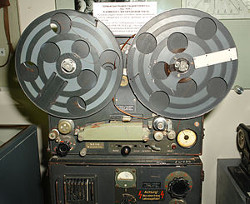Here in the Bay Area this is one of the true legends of Silicon Valley..
Flashback 1948: Ampex Unveils First Magnetic Tape Recorder

This cabinet-sized quarter-inch reel-to-reel magnetic plastic-tape machine — far superior to the handful of poor-quality paper-tape units on the market at the time — would lead directly to the development of the home stereo/hi-fi market, videotape recording, audiotape cartridge formats such as 8-track and Compact Cassette, and, ultimately, the videocassette, which set the stage for the home video revolution.
Magnetic audio-tape recording was actually — and mysteriously — developed by the German division of General Electric under the Nazis, with the creation of a deck dubbed the Magnetophon. The technology was unknown in the West until discovered by Army Signal Corps major John T. (Jack) Mullin after the war in the ruins of Radio Frankfort. Mullin shipped two Magnetophons and 50 reels of tape back to his home in San Francisco. After a year of tinkering, Mullin unveiled his own version of the Magnetophon at the Institute of Radio Engineers meeting on May 16, 1946.
 |
World War II-era Magnephoton from Germany. |
Ampex, founded in 1944 to make military motors and generators, decided making and selling these tape recorders would be a good post-war business re-direction. Mullin assisted Ampex engineers Harold Lindsay and Myron Stolaroff to develop a commercial version of the Magnetophon.
Engineers for Bing Crosby were immediately interested. Like all radio hosts of the day, Crosby was forced to perform two identical shows a day — one for the East Coast and one for the West Coast — because wax record recordings sounded awful and couldn't be edited. Crosby pre-ordered 20 decks at $4,000 each, many of which he then re-sold to ABC Radio, which provided Ampex with needed manufacturing capital.
In April 1948, Ampex shipped the first 200A units to Mullin and Crosby. With no patent issues, technology companies soon rushed their own reel-to-reel tape decks to market, revolutionizing both the radio and record businesses.
In 1951, Mullin, Ampex, and RCA engineers all began the next logical steps — adapting magnetic audio tape technology to record video. Ampex, led by Charles Ginsburg and a recent high school graduate named Ray Dolby, won this race to video when the company's Mark IV videotape recorder was unveiled to a shocked audience at NAB on April 14, 1956, revolutionizing the TV business and, soon, all of home entertainment.
But it all started 70 years ago this month with the introduction of the first successful commercial magnetic tape recording deck, the Ampex 200A.
For more on the history of magnetic recording, visit the Museum of Magnetic Sound Recording in Austin, Texas.
- Log in or register to post comments


I just happened upon this, and had no idea, nor had really wondered about the origin of tape recording. The Nazi's definitely had their hands on some advanced technology during that war. I had no idea the advancement of audio reproduction was due to them. CrazaY!
























































